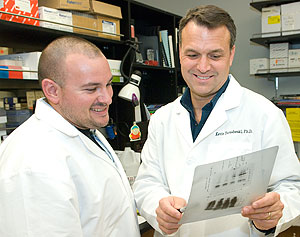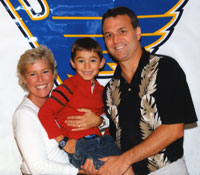He was born in central New Jersey, but Kevin E. Yarasheski, Ph.D., started moving west when he started college.
First it was to East Stroudsburg University in the Pocono Mountains of Pennsylvania, where he earned an education degree. Then he went farther west to Kent State University in Ohio, where Yarasheski earned both a master’s degree and a doctorate in exercise physiology.

He says his decision to pursue science as a career began with an interest in the biochemistry of physical activity. Yarasheski longed to understand what happened inside muscles during exercise, what activity did to the heart, the liver and fat stored in the body. He knew a research fellowship could allow him to explore not just exercise but also the other things that interested him, too.
“During graduate school, my adviser, who was a pretty good biochemist, really stimulated my brain and got me excited about discovery, thinking outside the box, ignoring boundaries, and dared me to imagine new approaches and new possibilities,” says the professor of medicine, of cell biology and physiology and of physical therapy. “I really became excited by bench research and understanding the molecular-level changes that explain disease.”
After graduate school, he kept going west, heading to St. Louis for that postdoctoral fellowship. As he changed time zones, his career direction changed, too. By the time he arrived at the School of Medicine, his primary interests involved transitioning his skills from the bench to disease-oriented human research and scientific discovery.
That desire to transition and gain novel research and analytical skills helps explain how an exercise physiologist eventually came to work with mass spectrometry, stable isotopes and imaging techniques. Yarasheski regularly uses those tools and “many of the other nice toys they have here at Washington U.” to better understand what goes wrong with the biochemical processes that regulate metabolism, body composition and cardiovascular function in people with HIV.
“I came here 22 years ago to learn and apply in vivo research techniques that would allow me to understand human biochemistry, and I’ve never left,” Yarasheski says. “The stimulation is just too great. I like the idea of coming to work and knowing that we’ve got the potential to discover something new. That’s what gets me out of bed every Monday morning and keeps me excited about science.”
When he arrived at the University, Yarasheski was working with colleagues interested in how human biochemistry changed as people got older. His research has evolved in the intervening two decades, and he now concentrates on how HIV infection affects the cardiovascular system and metabolism.
“Kevin is a perfect example of the value of involving people with fresh perspectives to address difficult problems, something that makes Washington University such a unique community of scholars,” says Clay Semenkovich, M.D., the Herbert S. Gasser Professor and chief of the Division of Endocrinology, Metabolism and Lipid Research.
“Very few people could have predicted that successful treatment of HIV would lead to metabolic abnormalities associated with heart disease,” Semenkovich says. “Kevin, with his background in human integrative physiology, has the ideal skill set to contribute new insights into an important problem.”
Studying HGH
Those studies of the elderly looked at many different things, but under the direction of John O. Holloszy, M.D., professor of medicine, the group’s primary focus was on interventions to slow or reverse frailty and metabolic problems associated with aging. Yarasheski says the projects paid important dividends in both scientific and personal ways.
As a scientist, he began to look at the effects of recombinant human growth hormone, often called HGH. He treated elderly people with HGH, gave it to younger people and measured its effects in the laboratory. His findings were — and remain — controversial. Yarasheski admits that in elite swimmers, for instance, when the difference between victory and defeat can be as narrow as .01 seconds, HGH might help performance. But those tiny differences are too small to measure in the laboratory.

“Study after study has shown that in people who have normal levels of growth hormone, the advantages of HGH are small; they retain fluid, become mildly hypertensive and develop carpal tunnel syndrome, muscle and joint soreness,” he says. “But as far as muscle strength and muscle performance go, growth hormone doesn’t do anything, at least not anything that we can measure in the lab.”
Growth hormone does help people who don’t have normal HGH levels. Short-stature children, for instance, can grow taller with hormone treatments. Older people deficient in growth hormone also can benefit, but Yarasheski remains unconvinced that anyone with normal HGH levels really gets bigger, stronger or faster.
But as the debate about HGH raged in the scientific and the popular press, Yarasheski had turned his skills toward a different issue. He was learning about biochemical changes in the muscles of AIDS patients. Muscle wasting was one of the major problems that accompanied HIV infection, and he had studied wasting in the elderly during his first days at WUSTL.
“I wanted to understand the molecular reasons why HIV caused wasting,” he explains. “When I first came here, we were looking at aging and asking why we lose muscle, why we become resistant to insulin and why we become obese as we age. HIV infection was just a different model for looking at many of the same questions.”
But then protease inhibitor therapy was introduced, and wasting from AIDS became very rare.
“It disappeared, but with longer survival came more diabetes and more problems with cholesterol and more bone loss and abdominal obesity,” he says. “We’re at the point now where we want to know why the cardiovascular system isn’t regulated properly in these patients and what we can do in an HIV-infected person who has these cardiovascular disease risk factors.”
|
Kevin E. Yarasheski |
|
Born: May 17, 1958, in Somerset, N.J. Education: B.A., education, 1980, East Stroudsburg University; M.A., exercise physiology, 1984, Ph.D., exercise physiology, 1986, Kent State University University position: Professor of medicine, of cell biology and physiology and of physical therapy; assistant director, Biomedical Mass Spectrometry Research Resource Family:Wife, Jill; son, Curtis Alexander (Kai), 7 |
Family life
The other dividend from those early days at WUSTL was much more personal. He met his future wife, Jill, at a division holiday party.”We dated for, I don’t know, 20 years, 30 years, something like that,” he jokes. “I was so devoted to scientific discovery that I put marriage and all that kind of stuff on hold.”
It wasn’t really that long, but they certainly qualify for a lengthy courtship. The two met in 1986. They were married in 1995. Their son, Kai, came into their lives about seven years ago. Kai is a nickname. He’s named after Jill’s and Kevin’s grandfathers: Curtis Alexander Yarasheski.
Although Yarasheski’s trek led him westward from New Jersey to St. Louis, most of the rest of his family went south. One brother remains in New Jersey, but his parents, Edward, a high-school math teacher, and Elsie, a pharmaceutical industry worker, retired to the Raleigh-Durham area of North Carolina. Two sisters and another brother also relocated there. And Kevin, Jill and Kai visit every spring.
“First, we visit the relatives, and then we head straight to Topsail Beach down near Wilmington, North Carolina,” he says. “We do a lot of walking and hiking on the beach, and we love to catch (and release) crabs and flounder, and we kayak the Intracoastal Waterway. You may have noticed how big my muscles are from all of the kayaking that we do.”
As he laughs about his physique, he also notes that his kayaking is in no way aided by HGH … not that it would help.